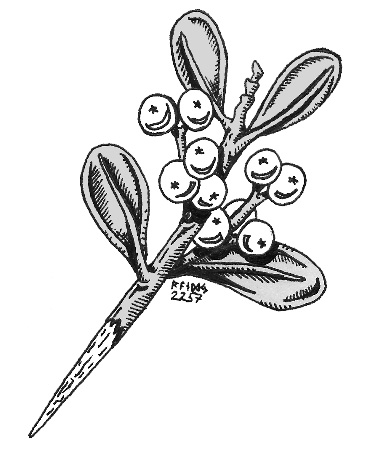there has to be an exception.
In Neil Gaiman's retelling Norse Mythology, he poetically NorsePlay'd that mistletoe's consent to not harm Baldr couldn't be obtained because it was too young to cognitively agree to Frigg's compact.
 |
| [book art illustration by Charles E. Brock (1930 CE).] |
I myself have speculated that perhaps mistletoe was a very latecomer in the spectrum of mythic time, a parasitical growth that appeared only after Frigg had locked down everything else's oath, which would make the most sense.
As I read Marvel Universe's entry on Baldr this week, the comic adaptation alternatively plays it this way:
"Because of prophecies that Balder's death would help trigger the coming of Ragnarok, the destruction of Asgard and its inhabitants, Odin, ruler of Asgard, commanded his wife Frigga to make Balder invulnerable to harm. Frigga cast spells that would protect Balder from harm by any living or inanimate thing while he was in the Asgardian dimension. (The legends describe her as extracting promises from all of these things not to harm Balder, as if they were all sentient and capable of speech.) The sole exception was mistletoe. This omission is probably not due to forgetfulness on Frigga's part, since she has not made him invulnerable to harm from mistletoe since his vulnerability to it became known. It is more likely that his vulnerability to mistletoe is a necessary side effect of the spells making him invulnerable to harm from other things."
Jackson Crawford tends to use the phrase "dream logic" to encapsulate instances in the Norse Lore where things may only be tried once and can only be solved a certain way, after which they can't be attempted again.
 |
| [Baldr's Bonfire by LM Moe (1906 CE).] |
Examples of this I can think of would be Groa failing to remove the shard of Hrungnir's whetstone weapon from Thor's head, or Beowulf/Sigurd needing a specific sword to defeat a monster, or the short-handled forging of Mjölnir.
 |
If we apply Marvel's necessary exception as a magical rule for Frigg's spell as a requirement of said dream logic, then this can also NorsePlay as a possible metaphysical mechanics explanation (though I still favour my above explanation of mistletoe's post-oath appearance, but there's always room to storytell it in different ways).
 |
| [from one of the coolest story arcs of The Mighty Thor!] |
Of course we can also note that many a character in the Marvel Universe has the opportunity to come back from the dead, and one has to wonder if that storytelling exception was perhaps inspired by the Völuspá's §62 where Baldr returns post-Ragnarök.
More broadly the mistletoe factor can be a comment on defying fate, or a tension building storytelling device, or a cautionary tale about poisonous plants, but like the Norse Lore's polyvalence in general, it's probably all the above.
Guillermo Maytorena IV knew there was something special in the Norse Lore when he picked up a copy of the d'Aulaires' Norse Gods and Giants at age seven. Since then he's been fascinated by the truthful potency of Norse Mythology, passionately read & studied, embraced Ásatrú, launched the Map of Midgard project, and spearheaded the neologism/brand NorsePlay. If you have employment/opportunities in investigative mythology, field research, or product development to offer, do contact him.


Comments
Post a Comment